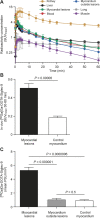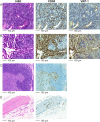Vascular adhesion protein-1-targeted PET imaging in autoimmune myocarditis
- PMID: 37758963
- PMCID: PMC10682147
- DOI: 10.1007/s12350-023-03371-8
Vascular adhesion protein-1-targeted PET imaging in autoimmune myocarditis
Abstract
Background: Vascular adhesion protein-1 (VAP-1) is an adhesion molecule and primary amine oxidase, and Gallium-68-labeled 1,4,7,10-tetraazacyclododecane-N,N',N″,N‴-tetra-acetic acid conjugated sialic acid-binding immunoglobulin-like lectin 9 motif containing peptide ([68Ga]Ga-DOTA-Siglec-9) is a positron emission tomography (PET) tracer targeting VAP-1. We evaluated the feasibility of PET imaging with [68Ga]Ga-DOTA-Siglec-9 for the detection of myocardial lesions in rats with autoimmune myocarditis.
Methods: Rats (n = 9) were immunized twice with porcine cardiac myosin in complete Freund's adjuvant. Control rats (n = 6) were injected with Freund's adjuvant alone. On day 21, in vivo PET/computed tomography (CT) imaging with [68Ga]Ga-DOTA-Siglec-9 was performed, followed by ex vivo autoradiography, histology, and immunohistochemistry of tissue sections. In addition, myocardial samples from three patients with cardiac sarcoidosis were studied.
Results: [68Ga]Ga-DOTA-Siglec-9 PET/CT images of immunized rats showed higher uptake in myocardial lesions than in myocardium outside lesions (SUVmean, 0.5 ± 0.1 vs 0.3 ± 0.1; P = .003) or control rats (SUVmean, 0.2 ± 0.03; P < .0001), which was confirmed by ex vivo autoradiography of tissue sections. Immunohistochemistry showed VAP-1-positive staining in lesions of rats with myocarditis and in patients with cardiac sarcoidosis.
Conclusion: VAP-1-targeted [68Ga]Ga-DOTA-Siglec-9 PET is a potential novel technique for the detection of myocardial lesions.
Keywords: Experimental autoimmune myocarditis; Siglec-9; myocarditis; positron emission tomography; sarcoidosis; vascular adhesion protein-1.
© 2023. The Author(s).
Conflict of interest statement
Mikko Mäyränpää received consultancy or speaker fees from Boehringer Ingelheim, Bristol-Myers Squibb, MSD, Takeda, Bayer, Amgen, and Roche not related to the present study. Dr. Knuuti received consultancy fees from GE Healthcare and AstraZeneca and speaker fees from GE Healthcare, Bayer, Lundbeck, Boehringer-Ingelheim, Pfizer and Merck, outside of the submitted work. Sirpa Jalkanen owns stocks in Faron Pharmaceuticals Ltd. Antti Saraste received consultancy or speaker fees from Amgen, Astra Zeneca, Boehringer Ingelheim, Abbott, and Bayer not related to the present study. The authors report no other potential conflicts of interest relevant to this article.
Figures






References
-
- Caforio AL, Pankuweit S, Arbustini E, Basso C, Gimeno-Blanes J, Felix SB, et al. Current state of knowledge on aetiology, diagnosis, management, and therapy of myocarditis: A position statement of the European Society of Cardiology Working Group on Myocardial and Pericardial Diseases. Eur Heart J. 2013;34:2636–2648. doi: 10.1093/eurheartj/eht210. - DOI - PubMed
Publication types
MeSH terms
Substances
LinkOut - more resources
Full Text Sources
Medical
Research Materials

